
Click to view fullscreen
Related Artworks
Discover similar artworks

Bacchanal
1615–42

An "Académie": One Man Lifting the Legs of Another Man
1742–43

Bust of Mme Mosion
18th–early 19th century

Le Grand Rocher (The Great Rock)
ca. 1625

Timocleia Before Alexander
ca. 1540–45

Ugolino
1860

Interior of a Barn with Milkmaid
ca. 1800

Portrait of Félix Bracquemond in 1852, from "L'Art"
1878

The Prodigal Son Changes His Clothes
ca. 1636

The Last Supper
1544

Turkey Keeper
1865

La Fuite de Clelie
1763–64
More by Jean Honoré Fragonard
Explore other works by this artist

Portrait of Jean Honoré Fragonard
1808

Vue des debris des bains de Neron from Differentes vues dessiné d'après nature... dans les environs de Rome et de Naples
18th century

Titlepage from Differentes vues dessiné d'après nature... dans les environs de Rome et de Naples
18th century

Vue des restes d'un théâtre from Differentes vues dessiné d'après nature... dans les environs de Rome et de Naples
18th century

Vue d'un temple... dédié à Diane from Differentes vues dessiné d'après nature... dans les environs de Rome et de Naples
18th century

Vue du Tombeau de Virgile from Differentes vues dessiné d'après nature... dans les environs de Rome et de Naples
18th century

Vue d'un ancien chateau scitué sur le chemin de Rome à Naples from Differentes vues dessiné d'après nature... dans les environs de Rome et de Naples
18th century

Imaginary View of a Roman Villa
mid-1770s

View of a Park
late 1770s

The Dreamer
late 1770s

The Draftsman
1770s

Landscape with Road and Monument
mid-18th century–early 19th century